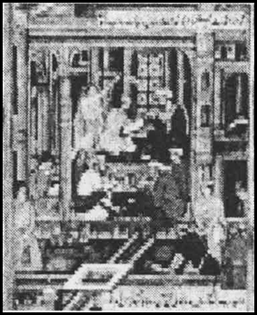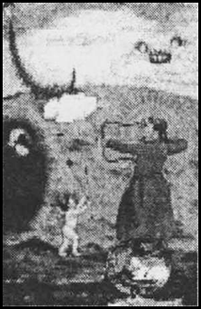Kings And Chronicles : The Mughal Courts
To what extent do you think the visual material presented in this chapter corresponds with Abu’l Fazl’s description of the taswir (Source 1)?
(a) Abul Fazl felt that drawing the likeness of anything is called taswir. He also believed that taswir’s had the power to make inanimate objects lok as if they possessed life.
(b) Taswir’s according to him not only enhanced the beauty of the book but used in Mughal chronicles possessed special powers of communicating ideas about the kingdom and the king’s power. The use of paintings however caused tension between the rulers and the ulema’s as Islam prohibited the depiction of human beings.
(c) The visual material present in this chapter does correspond with his description of the taswir, as can be seen from fig. 9.4 depecting a Mughal kitabkhana. Very clearly can be seen the calligraphers using the qalam to copy the text. The paper makers preparing the folios of the manuscripts and the painters illustrating various scenes.

A Mughal kitabkhana
(d) Similarly figure 9.7 showing Jahangir shooting the figure of poverty also contains symbols representing the idea of justice to which Jahangir was dedicated. The chains of justice are shown descending from heaven having been blessed by the gods. Another symbol signifying justice was the motif of the lion and lamb peacefully nestling to each other. This is found in the picture below the king’s feet indicating his love for justice. The divind theory of kingship is depicted by the crown coming down by heaven carried by two angels to be placed on Jahangir’s head.

Jahangir shooting the figure of poverty
Sponsor Area
Some More Questions From Kings And Chronicles : The Mughal Courts Chapter
Discuss, with examples, the distinctive features of Mughal chronicles.
To what extent do you think the visual material presented in this chapter corresponds with Abu’l Fazl’s description of the taswir (Source 1)?
What were the distinctive features of the Mughal nobility? How was their relationship with the emperor shaped?
Identify the elements that went into the making of the Mughal ideal of kingship.
Find out more about any one Mughal chronicle. Prepare a report describing the author, and the language, style and content of the text. Describe at
least two visuals used to illustrate the chronicle of your choice, focusing on the symbols used to indicate the power of the emperor.
Prepare a report comparing the present-day system of government with the Mughal court and administration, focusing on ideals of rulership, court rituals, and means of recruitment into the imperial service, highlighting the similarities and differences that you notice.
Why did Akbar abolish the pilgrimage tax? Give two reasons.
Mention the significance of Sijda in the Mughal court.
What was the form of greeting an ambassador was expected to offer while being presented before the Mughal emperor?
Mention the main objective of Akbar behind Jharokc Darshan.
Mock Test Series
Sponsor Area
NCERT Book Store
NCERT Sample Papers
Sponsor Area